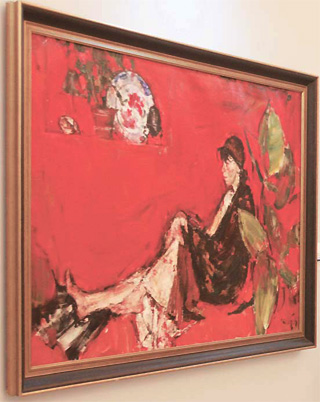 |
|
A painting from architect Sha Aide's Russian art collection
|
His collection of Russian artworks, numbering over 500, is also a tale of risk and timely opportunity.
He started collecting art in 2000. At first, it was Russian-style paintings by Chinese artists. But a chance encounter with a Chinese interpreter and close friend of acclaimed Russian artist Andrei Andreevich Mylnikov, left Sha dissatisfied with imitations.
The interpreter Peng Hongyuan had accompanied Mylnikov on his first visit to China in 1956 as part of a massive official scientific and cultural exchange between the former Soviet Union and China. She offered to arrange a visit for Sha with the master in 2003 to see Russian art of the finest order.
Over seven visits to Russia in the next six years Sha got to know the artist, now 90 years old, and his family, and bought 150 of his paintings.
Though he didn't make the acquisitions as an investment, the paintings have now risen steeply in value, much more than other more deliberate investments Sha made.
"I got a good price for the paintings as we had a good personal relationship, and also because in those days it was a tricky and pretty dangerous operation," reflects Sha.
"Russia was the first country I'd been to outside of China, I spoke no Russian, and knew no one but Mrs Peng who only accompanied me once. The first time I took just a small backpack.
"People laughed at me and said, 'Do you have enough money in there? Where will you put the paintings on the way back?'"
But as collecting became an obsession Sha has returned again and again. Usually unreceptive to foreigners, Mylnikov and Sha have struck up a good friendship. "He says I have the temperament of an artist," Sha remembers proudly.
Over the course of the visits, two which lasted over an hour, the Russian master gained enough trust in Sha to make a very special request. During his first visit to China in 1956 Mylnikov held an art workshop for members of various Chinese art schools.
During that class he painted a portrait of one of the class members, "the youngest and most lively one." When the painting was finished it turned out so well it became one of his favorites and he took it back to Russia.
Nearly 50 years later in 2004, he asked Sha to take the painting back to China, "where it really belongs," and to find the person portrayed in the painting. The artist really wanted to know what became of the young, lively person that once sat for him.
Sha duly brought the painting back and took out ads in Shanghai newspapers to find the man in the painting. However because Mylnikov's original art class was held in Chongqing Municipality, a Chongqing city reporter approached Sha and suggested he put a notice in their city paper instead.
It took no more than three days after the article was published in the Chongqing Morning Post before the man was found.
It turned out to be Professor Cai Zhenhui, the former vice director of the Sichuan Academy of Fine Arts. Cai had just come back from 10 years teaching art in the Phillippines, and was very happy to be found.
Two years earlier he had tried unsuccessfully to visit Mylnikov in Russia and had no idea the master was also looking for him.
"He is still as lively and talkative as ever," says Sha. "And when I told Mylnikov the news, he too was very happy and dedicated two ink drawings to us as a gift."
Back in Shanghai, Sha has selected works from his collection to show at the biggest art fairs every year since 2004. They have caught the attention of many in art circles but Sha is reluctant to part with his beloved paintings.
When late Chinese painter Chen Yifei wanted to buy some Mylnikov paintings from Sha, asking him to nominate any price, Sha was even more determined to sell nothing.
"Chen Yifei came to every exhibition and called me constantly. But I collect for the love of art so I was unwilling to part with my paintings, especially in the early days when I had just a few Mylnikov works."
He wants to keep in his family for later generations the best of the Russian paintings hoping they will also appreciate them as much as he does.
In 2004 Sha started his latest venture, the Shanghai St Peter Culture Exchange Company.
Based on his existing collection of art -- including Russian sculptures, ink drawings and paintings -- Sha wants to open a Russian Art Center in Shanghai and run it full time as a form of retirement. He says there's no such contemporary organization and he would like to contribute to greater Sino-Russo cultural exchange.
He is in the process of transferring his shares in the architecture businesses to concentrate on art in his late years.
"At one point I was running four companies, which was really stressful. I definitely want to be more relaxed. I want to travel to western Europe to widen my art appreciation and knowledge.
"There is something so mysterious about oil paintings, I can constantly find something new. The magic of Mylnikov's paintings lies in the way they are rooted in realism, but they transcend realism -- they capture the subject's soul."
(Shanghai Daily September 8, 2009)